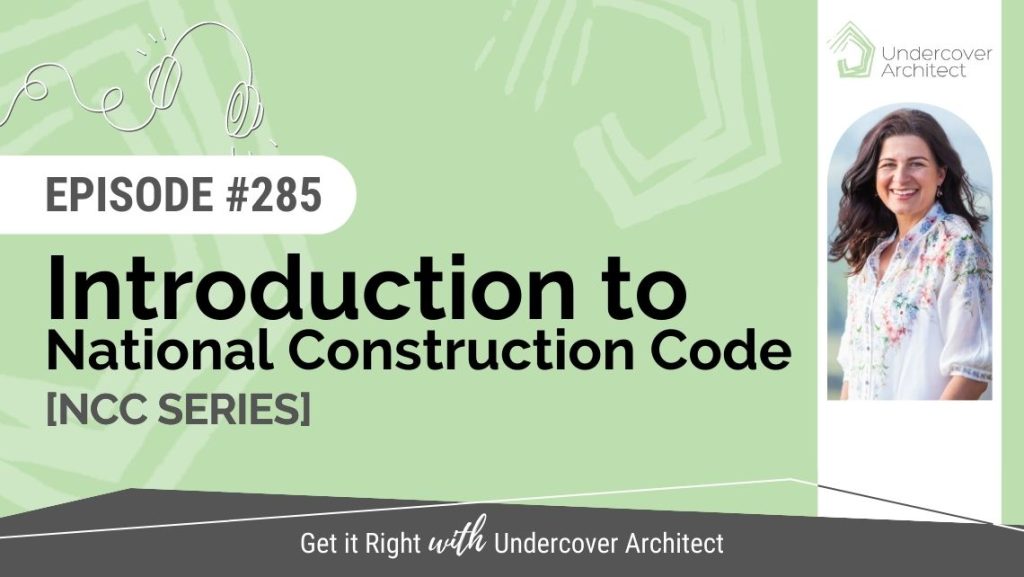
Want to learn more about the National Construction Code, and the changes and updates in NCC 2022?
This episode is part of a special series on the National Construction Code, and NCC 2022.
Listen to the episode now.
Hello! This is Episode 285. In it, I’m kicking off a series we’ll be running on the podcast over the next few months all about the National Construction Code (NCC).
You’ll learn more about what the NCC is, the updates and changes that have and continue to be made to it, and what you need to know about how it impacts your renovation or new build.
The National Construction Code is Australia’s regulatory framework for building and renovating all kinds of projects, not just residential homes. It’s a performance-based code that sets out the minimum level of performance that buildings, building elements, and plumbing and drainage systems must meet in Australia.
I know we have lots of non Australian listeners to the podcast. So whilst the introductory episodes I’m doing on the NCC will be specific to Australia, there is SO much coming in this series that will be super helpful wherever you’re located.
If you’re keen to know more about building for thermal comfort, with durability, longevity and home health in mind, this will be great information. So be sure to check out the upcoming episodes.
The NCC is updated every 3 years, however the latest 2022 update is one of the biggest updates so far, and its adoption has been delayed until this year, and is occurring differently around the country.
So, in this episode, I’m going to share information about what the NCC is and how it works.
I’ll also be sharing some of the updates made in our latest NCC2022.
And I’ll take you through the information you’ll be hearing about in the upcoming episodes.
Now, let’s dive in!
If you’re building or renovating your home in Australia, or planning to, you may have seen all the conversation happening in the industry about the National Construction Code.
That’s because its latest update, National Construction Code 2022, or NCC2022, is one of the most significant and contentious updates there’s been in a while. And there’s been a lot of opposition to it in certain sectors of the industry.
Given that the NCC governs the MINIMUM standard of design and construction in Australia, it basically represents the lowest standard that the industry can dish up to its consumers (which is really all of us when it comes to the built environment. We all live amongst this, and it impacts all of us).
The Australian Building Codes Board is responsible for writing the standards for the NCC, Watermark and CodeMark Certification Schemes, and regulatory reform in the construction industry. It does this on behalf of the Commonwealth Government.
And even the ABCB states in their documentation that:
The ABCB Standard is intended as a set of minimum necessary provisions, rather than as an exemplar of best practice. This is consistent with the role of the National Construction Code (NCC) which calls up this ABCB Standard.
Now, even with all the hoo-hah I want to say upfront, in my research, and in speaking with others I respect in the industry, these latest updates are good news.
As you’ll hear from many of my guests in the upcoming episodes, it’s still not enough to ensure we have homes that perform to the needs of our climate, their durability and longevity, and the expense homeowners are investing in them.
However the consensus is that things are definitely moving in the right direction.
How does the National Construction Code impact you as a homeowner?
Well, as a homeowner with plans to build or renovate, you need to be aware that the National Construction Code exists. And you need to check with your project team that they are up to date with NCC Performance Requirements and are applying them as decisions are made in your project.
And this needs to be done right from the outset, before you design, not just prior to construction.
LISTEN TO THE EPISODE NOW.
RESOURCES:
Please note, the links to some of these pages may be out of date or superseded as the NCC2022 adoption occurs, or (later) the NCC2022 is superseded by newer legislation.
National Construction Code 2022 >>> https://ncc.abcb.gov.au/editions/ncc-2022
NCC2022 state and territory adoption dates >>> https://abcb.gov.au/ncc-2022-state-and-territory-adoption-dates
NCC 2022 overview of key changes: articles >>> https://ncc.abcb.gov.au/ncc-2022-overview-key-changes-articles
NCC 2022 Resource Library >>> https://www.abcb.gov.au/resources
NCC Housing Provisions >>> https://abcb.gov.au/sites/default/files/resources/2023/NCC-2022-Housing-energy-efficiency-handbook-fa.pdf
Australian Building Codes Board NCC Series on YouTube >>> https://www.youtube.com/playlist?list=PLeJrC7bSBsBzpz0t7doKVO5N71RGI873g
Trajectory for Low Energy Buildings >>> https://www.energy.gov.au/government-priorities/buildings/trajectory-low-energy-buildings
Access the support and guidance you need to be confident and empowered when renovating and building your family home inside my flagship online program, HOME METHOD >>> https://undercoverarchitect.com/courses/the-home-method/
Learn more about how to interview and select the right builder with the Choose Your Builder mini-course >>> https://undercoverarchitect.com/courses/choose-your-builder
Access my free online workshop “Your Project Plan” >>> https://undercoverarchitect.com/projectplan


 With over 30 years industry experience, Amelia Lee founded Undercover Architect in 2014 as an award-winning online resource to help and teach you how to get it right when designing, building or renovating your home. You are the key to unlocking what’s possible for your home. Undercover Architect is your secret ally
With over 30 years industry experience, Amelia Lee founded Undercover Architect in 2014 as an award-winning online resource to help and teach you how to get it right when designing, building or renovating your home. You are the key to unlocking what’s possible for your home. Undercover Architect is your secret ally
Hi Amelia
Thank you for doing podcasts on the NCC. As always, very interesting.
We will be handing in our plans (own design, owner build) at the council soon, but expect it will not be before the 1st of October, because of delays from the engineer. Although we don’t foresee any issues with most of the new regulations (the house is designed for orientation, with hemp blocks, double glazing and Delta Panel roof), our concern is the access. The block is sloping, hence we dropped (just) the garage by 1m, so we’ll have a split level house with exterior steps to the front door and also in the garage leading into the house. A sliding door at the back could be the level access but there are other issues there, such as the cover needed.
To cut a long story short: would a (wheelchair) platform lift in the garage be deemed a suitable solution?
Many thanks for your input
Thanks for your feedback – glad that the episodes so far have been helpful, and hope that the upcoming ones are also.
In regards to your query, it’s really important that you speak to a local building certifier to understand how the regulations are being adopted in your state and for your property, and to determine whether you’ll need any Performance Solutions resolved for specific items such as this. In an upcoming episode with Laura Terrnova from Deemed to Perform, you’ll learn more about how the approval process can work, and what you might need to know. – Amelia, UA x